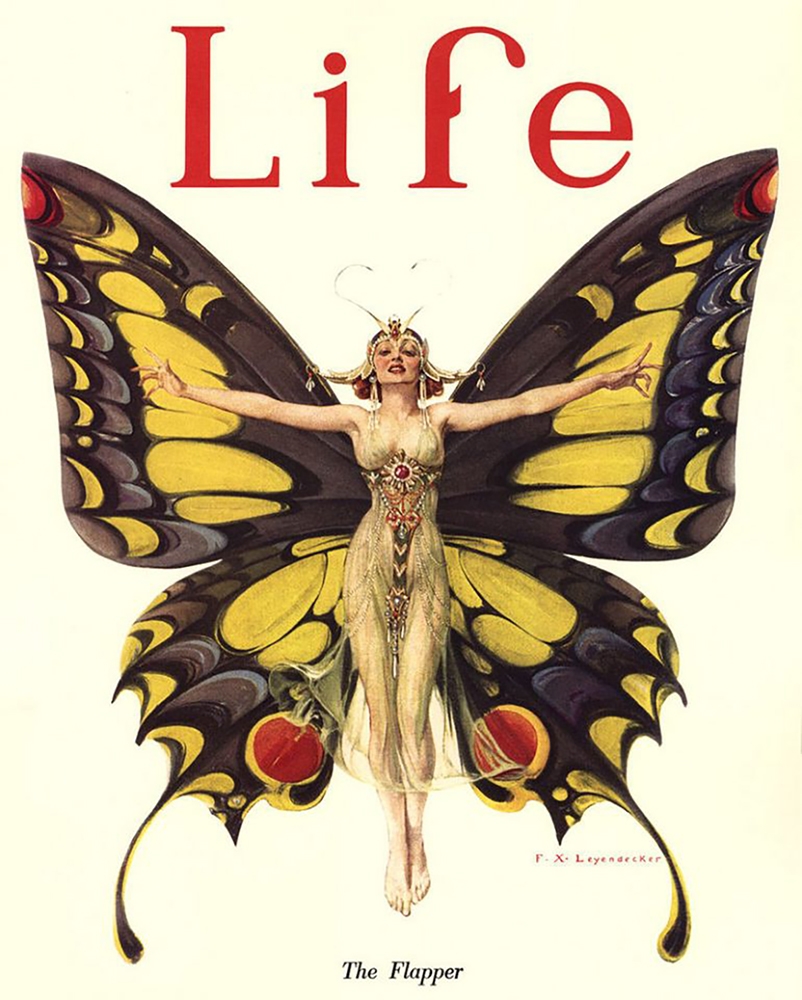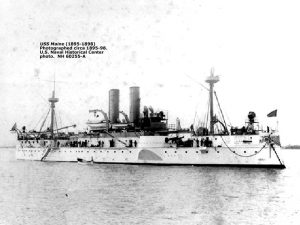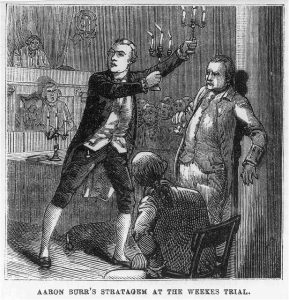Winner of the Fall 2016 StMU History Media Award for
Best Article in the Category of “Culture”
When one thinks of the 1920’s era one immediately thinks about Flappers. A flapper was considered a young woman who was very fashionable. This was a young female who enjoyed life to the fullest, flouting her unconventional standards of behavior and carefree party lifestyle.1 The spirit behind this movement was all about leaving the traditional ways of life behind and transforming into an independent woman.

Before World War I, the concept of femininity was referred to as the Gibson Girl. This term was used to describe these new independent and often well educated women. Gibson girls wore their hair long, pinned up and adorned with beautiful hats. They completed their ensemble by wearing long skirts and blouses that buttoned up to their necks. Despite their feminine appearance, these women were more than capable of doing the same things that men did. Examples of this include activities such as playing sports: skating, golfing, bicycling, tennis. These young ladies did not go out until they were asked properly by a young man who had good intentions and a promise of marrying them. Gibson Girls soon broke away from their traditional ways.2
In 1915, two years before America’s entry into World War I, a famous author by the name of H.L. Mencken introduced the word “Flapper” to the United States. Mencken stated that a flapper was “a woman who consumed music, literature and periodicals voraciously taking her cues for behavior and style from the media in front of her rather than the moral codes of decorum.”3 Another famous author, F. Scott Fitzgerald, famous for his classic novel The Great Gatsby, described the flapper as “lovely, expensive, and about nineteen.” John Held Jr., who was an American cartoonist, emphasized the flapper by drawing young girls wearing unbuckled galoshes that would make a “flapping” noise when walking.4 Despite the many different terms, Flappers were described essentially the same way: they were young girls who enjoyed the party life and had a sense of fashion.
After World War I ended in 1918, many things had changed for the men returning home, particularly the roles and values that women were embracing. The traditional values were gone and in their place came a faster, sleeker, and more daring approach to life. This time period not only ushered in an era of change in values, but it also established a new baseline for what was considered feminine. The Flapper Age was born and it brought with it a new and independent woman. These women smoked, drank, voted, cut their hair into bobs, wore eyeliner, and went to as many parties as they could—enjoying every bit of the social life along the way.5

During the 1920’s, fashion changed drastically due to a very famous designer, Coco Chanel. This woman helped flapper fashion to stand on its own. Typical flapper clothing included a simple sack like dress, which allowed women of all classes to make their own dresses and remain on trend.6 The waist of the dress was dropped to the hipline, and the skirt fell just below the knee. Stockings made of rayon were added and worn over a garter belt. To complete the look, bracelets were added and necklaces ran from the neck to the waist. Cloche hats sat atop their heads and drew the eye into a new hairstyle trend known as the bob.7 The make-up of flappers consisted of a red powder or cream that was used for the lips and cheek, eye-liner, powder for the face, and red lipstick that became very popular.
On January 19, 1919, the Eighteenth Amendment, also known as the Volstead Act, came into effect and gave way to the Prohibition Era in which the sale, production, importation, and transportation of alcohol was banned across the nation.8 This change in the legal system caused the sale and consumption of liquor and alcohol to go underground. The most rebellious thing a flapper could do at this time was to consume alcohol, and these young girls had a reputation for being giddy. The following year, on August 18, 1920, the Nineteenth Amendment was passed and women now had the right to vote.9 In 1924, the first radio launched more than 600 commercial channels around the U.S. The radio at the time was the social media on the flapper life. Many young girls swarmed the theaters to see the image of the flapper on screen. Famous actress Clara Bow, starred in the “Flapper” and made the look iconic.
On December 2, 1927, Henry Ford invented the Model A vehicle and car sales increased.10 Women were now owners of vehicles, and the car became a lifeline to a world full of excitement for the flapper in particular. With no one to stop them, they were free to come and go as they pleased. Liberated women were now able to go out and enjoy dancing during this era that was the Jazz Age. The most popular thing for a flapper to do was to go to a nightclub where she would drink, dance, and show off her moves. The era of the Flapper, however, came to an end with the Wall Street Crash of 1929. Many young women lost their jobs and the incomes that had given them such independence.11
Life in the 1920’s left a huge legacy for women to this day. Flappers and the forward-thinking concept of the modern woman is what initiated the change in society for how women were viewed then as well as how they continue to be viewed in present day. With their bold choice in attire, along with their new views and attitudes regarding femininity, both in fashion as well as social conduct, Flappers left behind the old traditional ways and paved the road for a more liberated female.
- Salem Press Biographical Encyclopedia, January 2016, s.v. “Flappers,” by R.L. Smith. ↵
- Kelly B. Sagert, Flappers: A Guide to an American Subculture (Greenwood Publishing Group, 2010), 1-2. ↵
- Brian DiPaolo, Flappers: Issues & Controversies in American History (Infobase Publishing, 2007), 4-5. ↵
- DiPaolo, Flappers: Issues & Controversies in American History, 4-5. ↵
- Soo Hyun Park, Flapper Fashion In the Context of Cultural Changes of America in the 1920’s (CUNY Academic Works, 2014), 1-2. ↵
- Salem Press Biographical Encyclopedia, January, 2016, s.v. “Flappers,” by R.L. Smith. ↵
- Sagert, Flappers: A Guide to an American Subculture, 3. ↵
- Sagert, Flappers: A Guide to an American Subculture, 5. ↵
- DiPaolo, Flappers: Issues & Controversies in American History, 2. ↵
- F.L. Allen, Only Yesterday: An Informal History of the Nineteen Twenties (National Humanities Center, 1931), 5. ↵
- Alan Brinkley, American History: Connecting with the Past Volume 2, 15 edition (New York: McGraw-Hill Education, 2014), 643. ↵




213 comments
Christine Sackey
The Great Gatsby is one of my favorite books and I love reading about the flappers and that era. I liked how they were independent, innovative, and risky. They did not care about what people think but they just want to do what they want. For example how they would sneak around and consume alcohol. Life seemed to be good to the flappers.
Anthony Robledo
This article is great! The way this article is constructed combined with the exquisite choices of imagery makes this article an amazing read. The way you describe a flapper as a lifestyle was good. Overall, this article does a great job empowering women. Especially during an almost opposite spectrum of judgment that we are now. Good job and keep at it! I’m hoping to read more articles similar to this.
Alejandra Mendez
The Roaring 20s is probably one of if not my favorite era to have studied. I read F. Scott Fitzgerald’s book, The Great Gatsby, in high school and ever since then, I was intrigued and became fascinated with the era. A flapper girl’s way of living makes it seem like they were happy all the time. I imagine their ambiance to be refreshing and very much alive. This marks a very important time in history that resulted in in women’s views of life and perhaps in fashion as well. Who knows what could have been now if it was not for those young women.
Kelley Salinas
I absolutely loved watching the Great Gatsby, it was my first look into the style of flappers and their style. It’s amazing how a sense of style can make a woman more empowered. This was the point in history when women broke out and made their presence known through their rebellious clothing. This article was a great read and I thoroughly enjoyed reading it.
Cherice Leach
The 1920’s has to be one of my favorite eras recorded in history. You’re probably already guessing why… the Flappers! These women were the new age that started new traditions for women that created an independence for them. This was the time women started to make a statement in what they would wear and how they would express themselves. I love this era because I believe, this is when the true beauty of expression in women started to develop.
Andrea Chavez
I had never heard the term “flapper” before this. This article was candy for my eyes. I really do enjoy articles that talk about the revolution women have over the years; and how does this relate to the attitudes that they adopted in those times. The fact that women were now getting employed surely helped to gain more freedom. And I like how it integrates the ways and fashions of Coco Channel. She is such an iconic character and such an inspiration for us women even now a days.
Justin Garcia
This is a very well constructed article. I enjoyed that the article tackled a very overlooked time period in U.S. History. Many people believe that women’s rights and equality wasn’t a subject until the women’s rights movement in later years of the 1900s. I liked how specifically this time period was really allowing Women to express themselves in ways that they could in earlier time periods. How women could wear different clothing from the traditional fashion for females. I also liked how this time period also tackled women’s suffrage since it was a hot topic for it’s time.
Mariet Loredo
This was a great article! When you think of the 1920s one of the first thing I think about is flappers. Flappers were women who become more independent because the men had gone to war. The began to change their clothes, and hairstyles. Did began doing things that they weren’t accustomed to. I believe that they also opened the era where women began to see that they weren’t less than men and made them want to stand for what they believe in.
Zeresh Haman
I loved reading this article, it was really interesting. I think that the concept of a “flapper” is something that a lot of people know about, but they don’t necessarily realize how drastic of a change that this was during the 1920’s. It was fun to read about Coco Chanel, and her role in the change of fashion during this time. I like reading the part about how the red lipstick came in to fashion. It was refreshing to read an article that was all about the women during this time. I think this was a really fun article, and a fascinating read.
Yahaira Martinez
Before this article, the only idea i had of a flapper was from The Great Gatsby and it was very brief. I love this article so much, not only because of how detailed the explanation of the flappers is, but because there is no negative relation associated when spoken about them. these women were rising from the shadows and learning how to become independent and expressing it through their image, their persona. Everything about them let people know that they were free and they were enjoying life and that nobody could them to do anything that they didn’t want to. I absolutely loved this article !